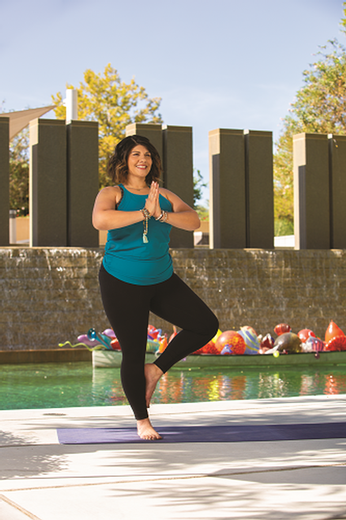Yoga for Cancer Patients

Yoga practitioner and instructor Shay Moraga, E-RYT 500, YACEP, knows what it’s like to hear those words. Diagnosed with breast cancer at age 38, she recalls her physical reaction to the news. “When they first told me I had cancer, I literally clenched my fists and held my breath,” says Moraga. “And every time I went to a doctor’s appointment, I held my breath because I didn’t know what they were going to tell me. I didn’t want them to tell me I was going to die.”
Moraga, a practitioner of yoga for nearly 20 years, practiced it during her pregnancy and again after her daughter was born. “Yoga gave me something I could be consistent with. It really bridges the mind/body connection. I love it,” says Moraga. But after being diagnosed with cancer, it took Moraga a while to return to the basic principles of yoga — breathing and movement.
“My yoga mentor called because she knew I was struggling after my cancer diagnosis,” explains Moraga. “She encouraged me to get back on my mat, because yoga is not just about the poses. Yoga starts from the inside and then it moves out. When I was finally able to breathe and move and connect with myself again, I was able to release the tension and anxiety and accept what was going to be. It was hard and sometimes uncomfortable, because I didn’t want to be there. But I decided that I needed to be on my mat every day, breathing…breathing.”
Yoga and breathing guided Moraga through each step of her treatment and recovery.
“When I learned to breathe again, I breathed through my doctors’ appointments, I practiced breathing before I went into surgery and I breathed again when facing chemotherapy,” shares Moraga. “I had to change the way I thought about chemotherapy from something toxic inside my body, to something that would kill my cancer cells. I focused on breathing from the tip of my toes to the top of my head.”
More than two years out from her cancer treatment, Moraga has been teaching yoga to cancer patients at Eisenhower Lucy Curci Cancer Center. She tells her students that it’s okay not to be okay, and that everyone has their own personal yoga journey with ebbs and flows, just like they have their own cancer journey with ebbs and flows.
“There are so many benefits of yoga, especially for a cancer patient, because it helps with lymphedema, it helps with bone loss and weight gain, and with range of motion and scar tissue,” says Moraga. “Different poses help with constipation and bloating and abdominal obstruction. It also helps with neuropathy and with strengthening your body in a way that is low impact.
“Yoga also helps with the immune system. And when you’re breathing and have more oxygen in your blood, your lymphatic system works better.
Moraga knows that chemotherapy is hard on the body and she knows what some of her yoga students face following surgery, like a double mastectomy — scar tissue. She also knows the relief her students feel after class when they’ve been able to let go and breathe and stretch their bodies, one class, one mat, at a time.
“It’s an ongoing process,” Moraga explains. “The class gives them an hour of peace and relaxation, and permission to cry or be angry or let go of the stuff that doesn’t serve them, and to count the blessings that they have.
“Where I’m at in my life, I want to talk about survivorship,” says Moraga. “The women and men who come to my classes at the Lucy Curci Cancer Center inspire me. Some of them are 10 to 20 years out from their cancer diagnosis. We need to hear their stories of survivorship. To a new cancer patient, hearing those stories is so important. It gives them hope.”
Eisenhower Lucy Curci Cancer Center
Wednesdays, 10:45 to 11:45 a.m.
To make a reservation, call 760.834.3798.
Physician referral required.
No charge for patients undergoing cancer treatment;
$5 charge per class for those no longer in treatment.